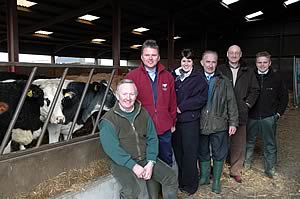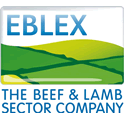 |
|||||||||
|
|||||||||||||||||||
|
|
Beef
Farmers Should Focus On Marketplace Requirements 18/12/07 Beef producers are losing as much as £12.5 million a year by marketing cattle with excess fat.
Northumberland beef farmers who attended an on-farm event in Ponteland were urged to maximise the efficiency of their enterprises through better nutrition, aiming to finish their cattle for a specific market and cutting costs by making use of manure. Former NFU county chairman Gordon Meek, who hosted the event at Eland Hall Farm, Ponteland, finishes Blonde-sired cattle from his 40-cow mostly Simmental cross suckler herd as well as bought-in stores. Cattle are mainly sold deadweight with steers at 22 to 24 months old while heifers are finished at 18 to 20 months to private butchers and wholesalers. Steve Powdrill, of EBLEX, said finishing cattle without subsidies, beef farmers needed to be focused on what they were producing and what the marketplace required. He said the majority of the market was looking for an R4L carcase but he said he still saw cattle which were as much as fat class at 6 to 8 on the EUROP scheme. “It’s a question of breeding for shape and feeding for finish. Length and depth of loin is what is required – not necessarily these huge rear ends,” he said. By using the EBLEX “virtual cow” he illustrated the skill of selecting cattle and the level of finish required both by visual appraisal and by handling. Carcases with inter-muscular fat had to be seamed out and were only good for mince however, even basic mince needed to be 80 per cent visual lean meat. Key handling points were over the pin bones and on either side of the tail head, the hindquarter, the loin, over the ribs and the chine and the shoulder blade ridge. He advised handling the left hand side of the beast as seen from behind as large amounts of kidney fat on the right hand side could be misleading. Dark cutting meat was thought to be down to stress and this did not sell well and its shelf life was also minimised. Also he advised to avoid bruising - so check for protruding bolts as ultimately the beef might not go to the market it was intended for as a result. The four recognised abattoir dressing specifications did not necessarily mean that the highest price per kilo represented the most money in your pocket. Between each of these specifications is a one per cent killing out percentage. Rations at Eland Hall cost 74p a day for the 350kg weaned calves, based on 0.46kg rapeseed meal, 0.05kg minerals, 0.44kg straw, 0.83kg grass silage, 2.58kg bread and 1kg chopped potatoes per head a day, fed through a Keenan TMR wagon. The cattle are achieving a daily liveweight gain of a kg a day. The finishing cattle receive double the amount of the ration ad lib with a DLWG of 1.6-1.7kg. “If you are putting these expensive feeds into your cattle you must ensure that you are getting the performance out of them,” said Seth Wareing, from Keenan Rumans. “People say they don’t have time to weigh their cattle but if you look at 10 per cent of your cattle, identify them in some way and record what you think the weight is then look at the group in another month’s time to calculate their daily liveweight gain. “We want to build frame in the growing cattle and not push for maximum liveweight gain then fill out the frame with flesh over a maximum 90-day finishing period.” He stressed the importance of maintaining as level a pH as possible in the rumen to help the cattle convert the feed to flesh by buffering with straw in the diet. Mr Wareing advocated the use of more home-grown feeds such as sugar beet, fodder beet and wholecrop maize which could work out cheaper per tonne of dry matter than wheat at current prices. With grass silage, reduce costs by making fewer, bigger cuts. “Efficiency is something we need to consider. It’s something that pig and poultry producers do and beef farmers need to get the hang of it,” Peter Dale, of ADAS, spoke of the need to carry out manure and fertiliser planning against a background of rising fertiliser costs, increased environmental pressure, catchment sensitive farming and changes in EU legislation. While average fertiliser use was falling which was correct for some but not for others so it was important to check soil analysis. “Nearly 50 per cent of arable fields and 30 per cent of grassland fields are at phosphorous index 3 or over so save money – little or no P is needed,” he said. He emphasised the value of manure. A typical application of dairy slurry was worth £50 a ha, FYM from cattle worth £90 while broiler little valued at £150/ha. Nitrogen was leached from manures applied in the autumn to both arable and grassland. He advised assessing how much fertiliser needed to be applied to meet the crops’ requirements. Use soil analysis every three to five years to know what the soil would provide and allow for the N, P and K from organic manures and select and apply the right fertilisers at the right amount and timing. The meeting also heard from Geoff Simpson, of Simpson and Allinson, Barnard Castle about the company’s innovative Roundhouse farm building which helps bring cost and time savings and improved growth rates.
| ||||||||||||||||||

|
|
||||||||||||||||||
| home | agri-services | pedigree
pen | news | dairy | beef | machinery property | organisations | site map |
|||||||||||||||||||

